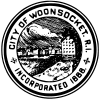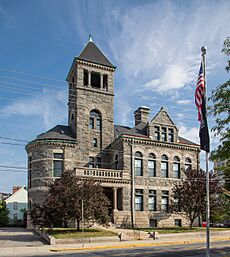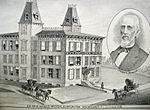Woonsocket, Rhode Island facts for kids
Quick facts for kids
Woonsocket
|
||
|---|---|---|
| City of Woonsocket | ||
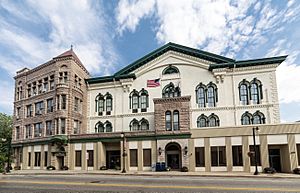
Woonsocket's city hall
|
||
|
||
| Motto(s):
"A City on the Move"
|
||
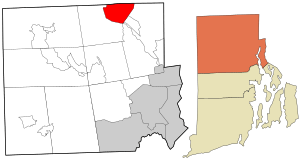
Location in Providence County and the state of Rhode Island
|
||
| Country | ||
| State | ||
| County | Providence | |
| Incorporated (town) | 1867 | |
| Incorporated (city) | 1888 | |
| Government | ||
| • Type | Mayor-council | |
| Area | ||
| • Total | 7.93 sq mi (20.55 km2) | |
| • Land | 7.75 sq mi (20.06 km2) | |
| • Water | 0.19 sq mi (0.48 km2) | |
| Elevation | 194 ft (59 m) | |
| Population
(2020)
|
||
| • Total | 43,240 | |
| • Density | 5,582.24/sq mi (2,155.42/km2) | |
| Time zone | UTC−5 (Eastern) | |
| • Summer (DST) | UTC−4 (Eastern) | |
| ZIP Code |
02895
|
|
| Area code(s) | 401 | |
| FIPS code | 44-80780 | |
| GNIS feature ID | 1219339 | |
| Website | www.woonsocketri.org | |
Woonsocket (![]() i/wʊnˈsɒkɪt, wən-/ WUUN-sok-IT-,_-WƏN--), is a city in Providence County, Rhode Island, United States. The population was 43,240 at the 2020 census, making it the sixth largest city in the state. Being Rhode Island's northernmost city, Woonsocket lies directly south of the Massachusetts state line and constitutes part of both the Providence metropolitan area and the larger Greater Boston Combined Statistical Area.
i/wʊnˈsɒkɪt, wən-/ WUUN-sok-IT-,_-WƏN--), is a city in Providence County, Rhode Island, United States. The population was 43,240 at the 2020 census, making it the sixth largest city in the state. Being Rhode Island's northernmost city, Woonsocket lies directly south of the Massachusetts state line and constitutes part of both the Providence metropolitan area and the larger Greater Boston Combined Statistical Area.
The city is the corporate headquarters of CVS Health, a pharmacy services provider. It is home to Landmark Medical Center, the Museum of Work and Culture, and the American-French Genealogical Society.
Contents
History
Before the arrival of European settlers in northern Rhode Island during the 17th century, today's Woonsocket region was inhabited by three Native American tribes: the Nipmuc (Cowesett), Wampanoag, and Narragansett. In 1661, the English theologian Roger Williams purchased the area from the "Coweset and Nipmucks", and in a letter referred to modern day Woonsocket as Niswosakit.
Other possible derivations of the name include several Nipmuc geographic names from nearby Massachusetts. These include Woonksechocksett, from Worcester County meaning "fox country", and Wannashowatuckqut, also from Worcester County, meaning "at the fork of the river". Another theory proposes that the city was named after Woonsocket Hill in neighboring North Smithfield.
Woonsocket Falls Village was founded in the 1820s. Its fortunes expanded as the Industrial Revolution developed in nearby Pawtucket. With the Blackstone River providing ample water power, the region became a prime location for textile mills. In 1831 Edward Harris built his first textile mill in Woonsocket.
The town of Woonsocket was not established until 1867, when three villages in the town of Cumberland, namely Woonsocket Falls, Social and Jenckesville, officially became the town of Woonsocket. In 1871, three additional industrial villages from Smithfield– Hamlet, Bernon, and Globe, were added to the town, establishing its present boundaries. Woonsocket was incorporated as city in 1888.
The growth of industries and associated jobs attracted numerous immigrants, predominantly Québecois and French-Canadians from other provinces. When the Société Saint-Jean-Baptiste d'Holyoke organized a national cultural and benefit society in 1899, the Union Saint-Jean-Baptiste d’Amérique, Woonsocket, with its proximity to several industrial areas having large French-Canadian populations, was chosen for the organization's headquarters.
By 1913, a survey by the American Association of Foreign Language Newspapers found the city had to have the 6th-largest population of French or French-Canadian foreign nationals in the country. In the decades that followed this population grew, and by time the local textile industry shuttered during the Great Depression, ethnic French Canadians comprised 75 percent of the population. French-language newspapers were published; radio programs, movies, and most public conversations were conducted in French. As recently as 1980, 70% of Woonsocket's population was of French-Canadian descent. The New England French language their ancestors spoke gradually vanished from public discourse.
Throughout the 20th century the city's fortunes ebbed and flowed with national trends. During the Great Depression the textile economy of Woonsocket came to an effective standstill; however, it was revived during World War II. The city became a major center of fabric manufacturing for the war effort, including production of military uniforms.
In the postwar years, the Woonsocket economy diversified as manufacturing declined, and other commercial sectors, such as retail, technology and financial services took hold. In the early 1980s Woonsocket was struggling with high unemployment rates.
Beginning in 1979, Woonsocket sponsored Autumnfest, an annual cultural festival that takes place on Columbus Day weekend, at World War II Veteran's Memorial State Park. It has become one of the city's most popular events, attracting thousands of attendees.
Geography
According to the United States Census Bureau, the city has a total area of 8.0 square miles (21 km2), of which 7.7 square miles (20 km2) is land and 0.3 square miles (0.78 km2) (3.14%) is water. Woonsocket is drained by the Blackstone River. Adjacent communities include Blackstone and Bellingham, Massachusetts, along with Cumberland and North Smithfield, Rhode Island.
Climate
Woonsocket has a strong humid continental climate (Köppen Dfa) with four distinct seasons. Being influenced by both the sea and the interior during winter, diurnal temperature variation is relatively high, with days most often being above freezing before severe frosts hit at night.
| Climate data for Woonsocket, Rhode Island (1991–2020 normals, extremes 1967–present) | |||||||||||||
|---|---|---|---|---|---|---|---|---|---|---|---|---|---|
| Month | Jan | Feb | Mar | Apr | May | Jun | Jul | Aug | Sep | Oct | Nov | Dec | Year |
| Record high °F (°C) | 71 (22) |
73 (23) |
82 (28) |
96 (36) |
97 (36) |
97 (36) |
101 (38) |
102 (39) |
97 (36) |
86 (30) |
80 (27) |
73 (23) |
102 (39) |
| Mean daily maximum °F (°C) | 37.8 (3.2) |
39.9 (4.4) |
47.3 (8.5) |
59.8 (15.4) |
69.9 (21.1) |
78.5 (25.8) |
84.0 (28.9) |
82.5 (28.1) |
75.4 (24.1) |
63.9 (17.7) |
53.4 (11.9) |
43.0 (6.1) |
61.3 (16.3) |
| Daily mean °F (°C) | 28.3 (−2.1) |
30.5 (−0.8) |
37.8 (3.2) |
48.9 (9.4) |
58.9 (14.9) |
67.9 (19.9) |
73.6 (23.1) |
72.1 (22.3) |
64.9 (18.3) |
52.9 (11.6) |
43.3 (6.3) |
33.8 (1.0) |
51.1 (10.6) |
| Mean daily minimum °F (°C) | 18.8 (−7.3) |
21.1 (−6.1) |
28.2 (−2.1) |
38.0 (3.3) |
47.9 (8.8) |
57.3 (14.1) |
63.3 (17.4) |
61.7 (16.5) |
54.4 (12.4) |
42.0 (5.6) |
33.2 (0.7) |
24.6 (−4.1) |
40.9 (4.9) |
| Record low °F (°C) | −8 (−22) |
−11 (−24) |
−2 (−19) |
18 (−8) |
26 (−3) |
38 (3) |
44 (7) |
43 (6) |
29 (−2) |
18 (−8) |
9 (−13) |
0 (−18) |
−11 (−24) |
| Average precipitation inches (mm) | 4.37 (111) |
3.67 (93) |
4.89 (124) |
4.71 (120) |
3.64 (92) |
4.26 (108) |
3.62 (92) |
4.01 (102) |
4.17 (106) |
5.08 (129) |
4.22 (107) |
5.27 (134) |
51.91 (1,319) |
| Average snowfall inches (cm) | 12.3 (31) |
10.7 (27) |
7.6 (19) |
1.9 (4.8) |
0.0 (0.0) |
0.0 (0.0) |
0.0 (0.0) |
0.0 (0.0) |
0.0 (0.0) |
0.1 (0.25) |
1.0 (2.5) |
7.9 (20) |
41.5 (105) |
| Average precipitation days (≥ 0.01 in) | 11.5 | 10.1 | 10.9 | 11.9 | 12.8 | 11.4 | 10.7 | 10.3 | 10.1 | 11.4 | 10.2 | 11.2 | 132.5 |
| Average snowy days (≥ 0.1 in) | 5.2 | 4.3 | 2.7 | 0.4 | 0.0 | 0.0 | 0.0 | 0.0 | 0.0 | 0.0 | 0.5 | 3.0 | 16.1 |
| Source: NOAA | |||||||||||||
Demographics
| Historical population | |||
|---|---|---|---|
| Census | Pop. | %± | |
| 1870 | 11,527 | — | |
| 1880 | 16,050 | 39.2% | |
| 1890 | 20,830 | 29.8% | |
| 1900 | 28,204 | 35.4% | |
| 1910 | 38,126 | 35.2% | |
| 1920 | 43,496 | 14.1% | |
| 1930 | 49,376 | 13.5% | |
| 1940 | 49,303 | −0.1% | |
| 1950 | 50,211 | 1.8% | |
| 1960 | 47,080 | −6.2% | |
| 1970 | 46,820 | −0.6% | |
| 1980 | 45,914 | −1.9% | |
| 1990 | 43,877 | −4.4% | |
| 2000 | 43,224 | −1.5% | |
| 2010 | 41,186 | −4.7% | |
| 2020 | 43,240 | 5.0% | |
| U.S. Decennial Census | |||
2020 census
The 2020 United States census counted 43,240 people, 18,287 households, and 9,497 families in Woonsocket. The population density was 5,582.2 inhabitants per square mile (2,155.3/km2). There were 19,754 housing units at an average density of 2,550.2 per square mile (984.6/km2). The racial makeup was 64.41% (27,850) white or European American (59.68% non-Hispanic white), 7.86% (3,399) black or African-American, 0.62% (267) Native American or Alaska Native, 5.79% (2,502) Asian, 0.06% (28) Pacific Islander or Native Hawaiian, 9.64% (4,167) from other races, and 11.63% (5,027) from two or more races. Hispanic or Latino of any race was 21.01% (9,086) of the population.
Of the 18,287 households, 27.8% had children under the age of 18; 30.2% were married couples living together; 33.9% had a female householder with no spouse or partner present. 34.6% of households consisted of individuals and 11.0% had someone living alone who was 65 years of age or older. The average household size was 2.5 and the average family size was 3.2. The percent of those with a bachelor’s degree or higher was estimated to be 12.4% of the population.
21.9% of the population was under the age of 18, 8.5% from 18 to 24, 29.1% from 25 to 44, 26.0% from 45 to 64, and 14.5% who were 65 years of age or older. The median age was 37.2 years. For every 100 females, the population had 104.9 males. For every 100 females ages 18 and older, there were 107.8 males.
The 2016-2020 5-year American Community Survey estimates show that the median household income was $44,310 (with a margin of error of +/- $2,816) and the median family income was $55,818 (+/- $4,785). Males had a median income of $38,889 (+/- $2,065) versus $27,544 (+/- $2,343) for females. The median income for those above 16 years old was $33,424 (+/- $2,183). Approximately, 15.0% of families and 21.0% of the population were below the poverty line, including 34.8% of those under the age of 18 and 15.1% of those ages 65 or over.
2010 census
At the 2010 census Woonsocket had a population of 41,186. The population was 71.3% non-Hispanic white, 14.2% Hispanic or Latino, 6.4% African American, 5.4% Asian, 0.4% Native American and 4.3% reporting two or more races.
Arts and culture
Historic sites
Properties and districts in Woonsocket listed on National Register of Historic Places:
- 1761 Milestone
- Allen Street Historic District
- Alphonse Gaulin Jr. House (1885)
- Bernon Worsted Mill (1919)
- Cato Hill Historic District
- Frank Wilbur House (1923)
- Glenark Mills (1865)
- Grove Street Elementary School (1876)
- Hanora Mills (1827)
- Harris Warehouse (1855)
- Henry Darling House (1865)
- Honan's Block and 112-114 Main Street (1879)
- Hope Street School (1899)
- Island Place Historic District
- Jenckes Mansion (1828)
- John Arnold House (1712)
- L'Eglise du Precieux Sang (1873)
- Linton Block (1888)
- Logee House (1729)
- Main Street Historic District
- North End Historic District
- Philmont Worsted Company Mill (1919)
- Pothier House (1881)
- Smith-Ballou House (1906)
- Smithfield Friends Meeting House, Parsonage and Cemetery (1719/1881)
- South Main Street Historic District
- St. Andrews Episcopal Chapel (1894)
- St. Ann's Church Complex (1913)
- St. Charles Borromeo Church Complex (1867)
- Stadium Building (1925)
- Union Village Historic District
- Woonsocket City Hall (1856)
- Woonsocket Civil War Monument (1868)
- Woonsocket Company Mill Complex
- Woonsocket Depot Square (1847)
- Woonsocket District Courthouse (1894)
- Woonsocket Rubber Company Mill (1857)
Notable people
- Greg Abate, musician
- Norm Abram, master carpenter, TV host/personality
- Nicholas Alahverdian, child welfare reform advocate and scammer
- Jonathan Earle Arnold, politician
- Lisa Baldelli-Hunt, politician
- Rocco Baldelli, former baseball player and current manager of the Minnesota Twins
- Latimer Whipple Ballou, congressman
- Bryan Berard, hockey player
- Brian Boucher, hockey player
- Josephine Byrd, civil rights activist
- Percy Daniels, populist politician
- Marcel Desaulniers, chef
- Eddie Dowling, actor, screenwriter and songwriter
- Allen Doyle, golfer
- Denise Duhamel, poet
- Gregory Duhamel, historian and author
- Susan Eisenberg, voice artist
- Eileen Farrell, opera soprano
- Marie Rose Ferron, stigmatist
- Ernest Fortin, theology professor
- Stuart Gitlow, physician
- Edward Harris, manufacturer, philanthropist, and abolitionist
- Gabby Hartnett, baseball player and manager
- Michelle Holzapfel, woodworking artist
- Ambrose Kennedy, congressman
- Clem Labine, baseball player
- Nap Lajoie (1874-1959), baseball player
- Neil Lanctot, historian and author
- Francis Leo Lawrence (1937–2013), college president
- William C. Lovering, congressman
- James McAndrews, congressman
- J. Howard McGrath, politician
- Dave McKenna, jazz pianist
- Susan Menard, politician
- Isabelle Ahearn O'Neill, Rhode Island's first woman legislator
- Edwin O'Connor, radio personality and novelist
- Aram J. Pothier, governor
- Duke Robillard, blues guitarist
- Christopher Robinson, congressman
- Mathieu Schneider, NHL hockey player
- Andre Soukhamthath, mixed martial artist
- Bill Summers, umpire
Filming location
Woonsocket has served as a filming location for several movies, including Lost in Woonsocket (2007), Hachi: A Dog's Tale (2009), and The Purge: Election Year (2016).
See also
 In Spanish: Woonsocket (Rhode Island) para niños
In Spanish: Woonsocket (Rhode Island) para niños


